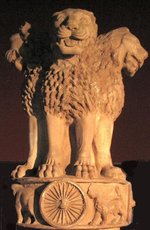Mauryan Empire
|
|
The Mauryan Empire was India's first great unified empire. It lasted from 321 to 185 BCE, and was ruled by the Mauryan dynasty. At its height it ruled virtually all of northern and central India and even parts of Afghanistan and Pakistan.
| Contents |
Formative period
When Alexander the Great conquered the north-western part of the Indian subcontinent in 326 BCE, he allied with king Ambhi of Taxila (called Taxiles or Omphis in Greek sources), and with his support managed to submit king Porus of Pauravas, a state of eastern Punjab, defeating him at the Battle of the Hydaspes River.
Alexander thereafter established vassal states (satrapies), headed by the previous kings Ambhi and Porus, and founded several garrison towns. A Greek satrap named Philippus controlled a Macedonian occupation force. After his assassination he was replaced by the Thracian Eudamus.
Following the refusal of his troops to go further east, Alexander returned to Babylon, and redeployed most of his troops west of the Indus. When Alexander died in Babylon soon after in 323 BCE, his empire fragmented, which opened up opportunities for the rise of new kingdoms everywhere, an opportunity seized in India by Chandragupta Maurya.
The rise of a unified state
Chandragupta (known to the Greeks as Sandracotta) was a member of the warrior caste of the Kshatriya. He was originally from the Taxila area, and had had many opportunities to observe the Greeks.
After the dislocation of Alexander's empire, he established an army with fighting techniques inspired from those of the Macedonians. Then, Chandragupta went east to overthrow the Nanda dynasty of the Magadha region, and "with the help of Macedonian mercenaries, (he) had established a kingdom in the Ganges Basin" (Robert Morkot) by 321 BCE.
Chandragupta then invaded the Punjab, after one of Alexander's satraps, Peithon of Media had tried to raise a coalition against him. He managed to conquer the Punjab capital of Taxila.
The Mauryan empire
MauryanCoin.JPG
Chandragupta
Chandragupta was again in conflict with the Greeks, when Seleucus I, ruler of the Seleucid Empire, tried to reconquer the northwestern parts of India which had been lost, during a campaign in 305 BCE.
Chandragupta defeated Seleucus and then the two rulers exchanged a peace treaty, Chandragupta received the daughter of the Seleucid king Seleucus I and the territories of Gandara and Arachosia, and Seleucus I received 500 war elephants that were to have a decisive role in his victory against western Hellenistic kings at the Battle of Ipsus in 301 BCE. Diplomatic relations were established, and several Greeks, such as the historian Megasthenes, resided at the Mauryan court.
Chandragupta established a strong centralized state with a complex administration under the advisorship of Kautilya, established at the capital of Pataliputra, which, according to Magasthenes, was "surrounded by a wooden wall pierced by 64 gates and 570 towers (and) rivaled the splendors of contemporaneous Persian sites such as Susa and Ecbatana".
Bindusara
Chandragupta's son Bindusara extended the rule of the Mauryan empire towards central and southern India. He also had a Greek ambassador at his court, named Deimachus (Strabo 1–70).
Asoka
Chandragupta's grandson Asoka (273- 232 BCE), is said to have been the greatest of the Mauryan emperors. He converted to the Buddhist faith following remorse for his bloody conquest of the kingdom of Kalinga in Orissa. He became a great proselytiser of Buddhism, insisting on non-violence to humans and animals (ahimsa), and general precepts regulating the life of lay people. He is said to have built 84,000 Buddhist stupas throughout India, as well as roads and hospitals.
According to the Edicts of Asoka, set in stone, some of them written in Greek, he sent Buddhist emissaries to the Greek lands in Asia and as far as the Mediterranean. The edicts name each of the rulers of the Hellenic world at the time..
Decline
The reign of Asoka was followed for 50 years by a succession of weaker kings. Brhadrata, the last ruler of the Mauryan dynasty, ruled territories that had shrunk considerably from the time of emperor Ashoka, but he was still upholding the Buddhist faith.
He was assassinated in 185 BCE during a military parade by the commander-in-chief of his guard, the Brahmin general Pusyamitra Sunga, who then took over the throne and established the Sunga dynasty.
The assassination of Brhadrata and the rise of the Sunga empire led to a wave of persecution for Buddhists, and a resurgence of Hinduism.
It also triggered the 180 BCE invasion of northern India by the Greco-Bactrian king Demetrius, who went as far as Pataliputra and established an Indo-Greek kingdom that was to last close to two centuries until around 10 BCE, and under which Buddhism was able to flourish.
Template:Middle kingdoms of India
See also
History of Buddhism
History of India
List of Maurya emperors
References
"The Penguin Historical Atlas of Ancient Greece" by Robert Morkot ISBN 0140513353de:Maurya fr:Dynastie et Empire maurya ja:マウリヤ朝 zh:孔雀王朝

